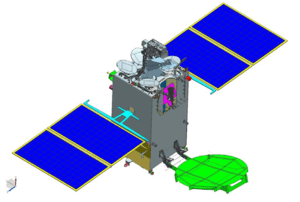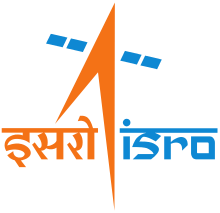GSAT
The GSAT (Geostationary Satellite)[1] satellites are India's indigenously developed communications satellites, used for digital audio, data and video broadcasting. As of 5 December 2018, 20 GSAT satellites of ISRO have been launched out of which 14 satellites are in service.
 The GSAT-7A, a military communications satellite, in deployed configuration | |
| Manufacturer | ISRO |
|---|---|
| Country of origin | India |
| Operator | INSAT |
| Applications | Communications |
| Specifications | |
| Regime | Geostationary orbit |
| Production | |
| Status | In service |
| Launched | 20 |
| Operational | 14 |
| Retired | 6 |
History
The GSAT series of geosynchronous satellites is a system developed by ISRO with an objective to make India self-reliant in broadcasting services. The repertoire of 10 GSAT satellites, a total of 168 transponders (out of which 95 transponders are leased out to provide services to the broadcasters) in the C, Extended C and Ku-bands provides services to telecommunications, television broadcasting, weather forecasting, disaster warning and search and rescue operations.
List of active satellites
This is a list of GSAT current satellites with their outcome.
| Satellite | Longitude | Date of launch | Launch vehicle | Lift-off mass | Status | Notes | ||
|---|---|---|---|---|---|---|---|---|
| GSAT series | INSAT series | Known as | ||||||
| GSAT-6 | INSAT-4E | 83° East | 27 August 2015 | 2,132 kg (4,700 lb) | In service | A multi-media mobile satellite system; will offer a Satellite Digital Multimedia Broadcasting (S-DMB) service, via mobile phones and mobile video/audio receivers for vehicles; Can also be utilized for strategic and social applications. | ||
| GSAT-7 | INSAT-4F[2] | Rukmani | 74° East | 30 August 2013 | 2,650 kg (5,840 lb) | In service | According to defense experts, to enable the Indian Navy to acquire blue water capabilities and need not depend on foreign satellites like Inmarsat, which provide communication services to its ships. | |
| GSAT-7A | - | Angry Bird | 19 December 2018 |
2,250 kg (4,960 lb) |
In service | GSAT-7A is an advanced military communications satellite meant exclusively for the Indian Air Force. | ||
| GSAT-8 | INSAT-4G | GramSat 8[3] | 55° East | 20 May 2011 | 3,093 kg (6,819 lb) | In service | To augment the capacity in the INSAT system; The GAGAN payload provides the Satellite Based Augmentation System (SBAS), through which the accuracy of the positioning information obtained from the IRNSS Satellites is improved by a network of ground-based receivers and made available to the users in the country through the geostationary satellites. | |
| GSAT-9 | - | South Asia Satellite | 48° East | 5 May 2017 | 2,330 kg (5,140 lb) | In service | Carried GAGAN navigation payload, a regional navigational services by NAVIC, a navigational system developed by India, that provides navigational services to the security forces and air traffic control organizations. | |
| GSAT-10 | - | 83° East | 29 September 2012[4] | 3,435 kg (7,573 lb) | In service | To augment telecommunication, Direct-To-Home and radio navigation services. | ||
| GSAT-11 | - | 74° East | 4 December 2018 | 5854 kg
(12,906 lb) |
In service | Aimed at providing advanced telecom and DTH services in the country. Heaviest satellite build by India. | ||
| GSAT-12 | - | GramSat 12[5] | 83° East | 15 July 2011 | 1,412 kg (3,113 lb) | In service | Replacement of the INSAT-3B; to provide services like tele-education, tele-medicine, disaster management support and satellite internet access. Only GSAT satellite to be launched by PSLV. | |
| GSAT-14 | - | 75° East | 5 January 2014 | 1,982 kg (4,370 lb) | In service | To replace the GSAT-3 satellite; launched by a GSLV Mk.II, which incorporated an Indian-built cryogenic engine on the third stage. | ||
| GSAT-15 | - | 93.5° East | 10 November 2015 | 3,100 kg (6,800 lb) | In service | Similar to GSAT-10 satellite; to augment the capacity of transponders to provide more bandwidth for Direct-to-Home television and VSAT services. | ||
| GSAT-16 | - | 55° East | 6 December 2014 | 3,150 kg (6,940 lb) | In service[6] | The communication payloads provide a combination of total 48 transponders across the three frequency bands (24-Normal C, 12-Extended-C and 12 in Ku-band) along with a Ku-band beacon transmitter, which is the highest for an Indian satellite. The spacecraft will be Co-located with GSAT-8 at 55 deg E. | ||
| GSAT-17 | - | 93.5° East | 28 June 2017 | 3,477 kg (7,551 lb) | In service[7] | Payload includes 24 C-band, 2 lower C-band, 12 upper C-band, 2 CxS (C-band up/S-band down), and 1 SxC (S-band up/C-band down) transponders as well as a dedicated transponder for data relay (DRT) and search-and-rescue (SAR) services. | ||
| GSAT-18 | - | 74° East | 5 October 2016 | VA-231 |
3,404 kg (7,505 lb) | In service[7] | to provide services in Normal C-band, Upper Extended C-band and Ku-bands of the frequency spectrum.[8] | |
| GSAT-19 | - | 48° East | 5 June 2017 | 3,136 kg (6,914 lb) | In service[9] | Maiden (developmental) flight of GSLV Mark III | ||
| GSAT-29 | - | 55° East | 14 November 2018 | 3,423 kg (7,546 lb) | In service[10] | Second developmental flight of GSLV Mark III | ||
| GSAT-30 | 83° East | 17 January 2020 | 3,547 kg (7,820 lb) | In Service[11] | Replacement satellite for INSAT-4A | |||
| GSAT-31 | 48° East | 6 February 2019 | 2,535 kg (5,589 lb) | In Service[12] | ||||
List of upcoming GSAT satellites
| Satellite | Longitude | Date of launch | Launch vehicle | Lift-off mass | Status | Notes | ||
|---|---|---|---|---|---|---|---|---|
| GSAT series | INSAT series | Known as | ||||||
| GSAT-7B | - | 20XX | Planned | |||||
| GSAT-7C | - | 20XX | Planned | |||||
| GSAT-7R | - | 20XX | Planned | Replacement for GSAT-7 Rukmini[13] | ||||
| GSAT-12R | - | 2020
(Planned) |
1,500 kg (3,307 lb) | Planned[14] | ||||
| GSAT-20 | - | June 2020
(Planned) |
5,300 kg (11,684 lb) | Planned[15] | ||||
| GSAT-22 | - | 2020 (planned) | Planned[16] | |||||
| GSAT-23 | - | 2020 (planned) | Planned[16] | |||||
| GSAT-24 | - | 2020 (planned) | Planned[16] | |||||
| GSAT-32 | February 2020 | Planned | Replacement of GSAT – 6A. | |||||
List of defunct satellites
| Satellite | Longitude | Date of launch | Launch vehicle | Lift-off mass | Status | Notes | |||
|---|---|---|---|---|---|---|---|---|---|
| GSAT series | INSAT series | Known as | |||||||
| GSAT-1 | - | GramSat 1[17] | 73° West (2000) 99° West (2000–2006) 76.85° West (2006–2009) |
18 April 2001 | 1,540 kg (3,400 lb) | Failed to orbit (Experimental satellite) |
Envisaged as a technology demonstrator; Failed to achieve its target orbit, which prevented it from fulfilling its primary communications mission. | ||
| GSAT-2 | - | GramSat 2[18] | 47.95° East | 8 May 2003 | 1,825 kg (4,023 lb) | Decommissioned (Experimental satellite) |
Experimental communication satellite on board the second developmental test flight of India's GSLV. | ||
| GSAT-3 | - | EduSat | 74° East | 20 September 2004 | 1,950 kg (4,300 lb) | Decommissioned (30 September 2010) |
Built exclusively to serve the educational sector. It was mainly intended to meet the demand for an interactive satellite-based distance education system for the country. | ||
| GSAT-4 | - | HealthSat | 82° East | 15 April 2010 | 2,220 kg (4,890 lb) | Failed to orbit | Experimental communication and navigation satellite; maiden flight of the GSLV Mk.II rocket. | ||
| GSAT-5 | INSAT-4D[19] | 2,250 kg (4,960 lb) | Cancelled | Rebuilt as the GSAT-5P. | |||||
| GSAT-5P | - | 55° East | 25 December 2010 | 2,310 kg (5,090 lb) | Failed to orbit | As a replacement for INSAT-3E. | |||
| GSAT-6A | - | 29 March 2018 | 2,140 kg (4,720 lb) | Communication lost | Communication with the satellite was lost after the second orbit raising manoeuvre. Efforts are on to re-establish link but at this point it remains incommunicado.[20] | ||||
See also
References
- "ISRO GeoStationary Satellites". isro.org. Archived from the original on 11 February 2014.
- "GSAT 7". NASA. 16 August 2013. Retrieved 6 January 2014.
- "GSAT 8". NASA. 16 August 2013. Retrieved 6 January 2014.
- "GSAT 10". NASA. 16 August 2013. Retrieved 6 January 2014.
- "GSAT 12". NASA. 16 August 2013. Retrieved 6 January 2014.
- "Ariane 5 delivers DIRECTV-14 and GSAT-16 to orbit on Arianespace's latest mission success". Archived from the original on 11 December 2014. Retrieved 7 December 2014.
- "Annual Report 2015-2016" (PDF). Indian Space Research Organisation. December 2015. p. 28. Archived from the original (PDF) on 2016-07-05.
- "GSAT-18 launched successfully on board Ariane-5 from Kourou in French Guiana". 2016-10-06. Retrieved 2016-10-06.
- "Now, ISRO successfully puts GSAT-19 satellite in orbit with GSLV Mk-III". The New Indian Express. Retrieved 5 June 2017.
- ISRO successfully launches the GSAT-29 satellite from Satish Dhawan Space Center in Sriharikota on Wednesday. Bangalore Mirror. 14 November 2018.
- "India's communication satellite GSAT-30 launched successfully". ISRO. Retrieved 17 January 2020.
- "India's 40th Communication Satellite, GSAT-31, Launched". NDTV. Retrieved 6 February 2019.
- "Navy to buy Rs 1,589 crore satellite from ISRO". Economic Times. Retrieved 18 July 2019.
- "GSat 12r". orfonline. 13 Jan 2020. Retrieved 13 Jan 2020.
- "GSat 20". Gunter's Space Page. 2 June 2017. Retrieved 2 June 2017.
- "GSAT 22/23/24". Indian Defense News. 25 April 2017. Retrieved 16 February 2018.
- "GSAT 1". NASA. 16 August 2013. Retrieved 6 January 2014.
- "GSAT 2". NASA. 16 August 2013. Retrieved 6 January 2014.
- "GSat 5 (Insat 4D)". Gunter's Space Page. 29 March 2017. Retrieved 22 May 2017.
- https://www.isro.gov.in/update/01-apr-2018/second-orbit-raising-operation-of-gsat-6a-satellite-has-been-successfully-carried

